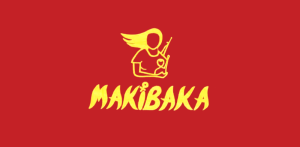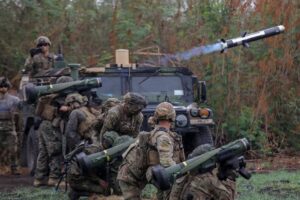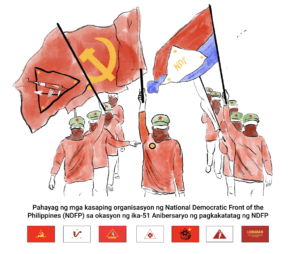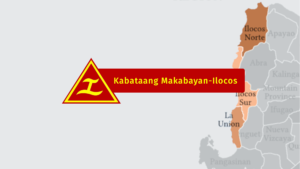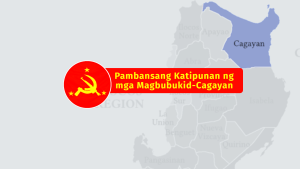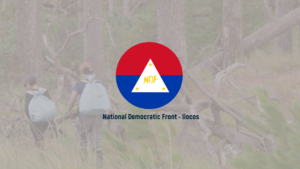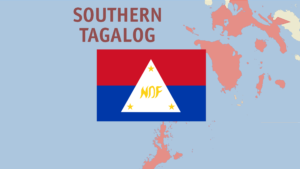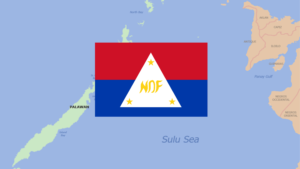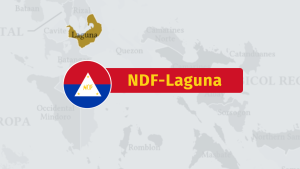Especially in Negros Island, the fire of agrarian revolution is never quenched
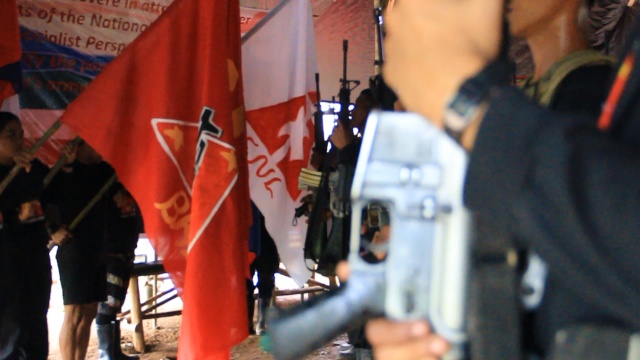
Note: The Christians for National Liberation (CNL), the revolutionary organization of Christians, marks the peasant month of October with a feature article on Negros Island where chronic poverty, exploitation and rights violations especially against farmers and farm workers prevail. Deemed a social volcano, Negros showcases heightening resistance and revolution against imperialist and semi-feudal systems. CNL embraces the peasant struggle for genuine agrarian revolution and the justness of waging people’s war.
Negros Island, notoriously known for hacienda problems, is never without any agrarian conflict. In October 2018, for instance, nine (9) farm workers were heinously shot dead in Hacienda Nene, Sagay City, Negros Occidental. Malacanang was quick to blame it on the New People’s Army (NPA) but in truth, it was done by the armed militia of pro-government landlord politicians. Rudy of Sagay City, Negros Occidental said: “It is the armed group of the hacienderos [landlords] who killed the farm-workers.” The armed groups of the landlord politicians, who were well-equipped, many times had made killing rampages among the poor peasants and did this without impunity. They knew that they were greatly supported by the local government and tolerated by the local military agencies in Negros.
The killings were done to sow fear among the poor hacienda farm workers and peasants so that the poor would be forced to agree with the unjust terms of work set by the landlords. Those who complained would get death threats and if they persevered in resisting, would finally be shot dead. This glaring inhuman situation, though greatly known, had not been fully redressed because the rich landlords in Negros freely wield their might without any fear. The landlords are power brokers or they themselves hold the political power from the top to the base of the government’s political structure.
The island was relatively peaceful before the colonial government of Spain established the hacienda system. The island was owned by locals who cultivated this for rice, vegetables and fruit trees. The Spanish colonial government expropriated the land from them by force and established the hacienda system. The haciendas or big tracts of land were given to Spanish families and persons who were loyal to the Spanish colonial government. The hacienda was established in order to cultivate the island for cotton to provide raw materials for the textile industry. When sugar became more profitable than cotton, the haciendas were converted into sugarcane farms. Sugar mills were also established. The locals were forced to go to the hillsides and other parts of the island where it is difficult to plant sugarcanes.
After the colonial period, the locals tried to use the country’s legal system to get back the land of their ancestors but the formidable power of the hacienderos were so strong that the corrupt local courts would always favor the hacienderos. Some aggrieved local people would resort to burning the sugar farms or to occupy some lots of the hacienda. Consequently, the armed groups of the hacienderos would then go on a killing rampage to scare off the local settlers and protect the rich hacienderos who would wield oppressive power with impunity against the poor peasants.
Through all the years, there would always be land problems in Negros Island. The hacienderos (landlords) would manifest their untouchable might and strengthen their own armed groups to protect their property. They hired sugarcane farm workers from other islands and they were called sacadas because they were working to pay the debts of their families who received money from the haciendero. Some of the farm workers in the hacienda would be paying the debts of their grandparents. It was an enslavement of the sacadas. The sacada system later evolved into a contractual system. It was the same exploitative system but the hacienderos would be hiring contractors to get some farm-workers. The injustices and oppressions in the sugar farms went on unabated. The hacienderos were adamant in their position on the land. The government came in and cajoled the people in a fake land reform program. The people realized that this was not a real land reform program. They joined the rebels to fight for genuine land reform and agrarian revolution.
Victor, a farm worker of Sagay City, pointed out: “The haciendero [landlord] family and clan keep all the positions. The governor, the mayor, the vice mayor, the Councilors, the Barangay Chairman, and other officials are from the same family.” Political dynasties existed in Negros and powerful landlord families would do everything to make their political clout be felt by the people. Lucio added: “They have everything. They have political power. They have vast lands. They have a lot of money. They have their armed guards. We, poor people, do not have anything. We are nothing. We only have hope. If we are united, we can do something more.” This made the agrarian issue in Negros complex and explosive. It is like a volcano that is ready to explode.
Another farm worker, Teresita, narrated about the poor farmers’ bad experience regarding the government’s Comprehensive Agrarian Reform Program (CARP): “We have nothing. In the CARP of the government, the government bought a portion of hacienda land and subdivided it into small lots. The lots were supposed to be awarded to the people. We thought it was for real. We were happy and agreed to pay the amortization of the land. We started to pay in installments to own the land even from our hard-earned savings. But the hacienda lots were not really awarded to us poor farm workers. We got the CLT (Certificate of Land Transfer) and the CLOA (Certificate of Land Ownership Award) but the hacienderos (landlords) kept their land. We could not get it. They were guarded by armed groups of the haciendero [landlord].” This poor farm worker was deceived by an oppressive and farce land reform program of the Philippine government.
The CARP was a sham land reform program using the technique of market-assisted land reform (MALR). The practice was that the landlords who were willing to sell to the Department of Agrarian Reform (DAR), through the Landbank, a little portion of their land—and usually these portions are less fertile—would have an agreement with the office of the DAR for the sale of hacienda lots. The farm workers will be gathered by the local DAR personnel and an agreement will be forged by those present that the people will pay the amortization of the said land lots which are around 1 hectare per family. If the lots are a little fertile, they will have the scheme of co-ownership through SDO (Stock Distribution Option). A farmer worker, Onesimo, commented on this SDO: “We work and work without fee because we thought we owned the land. The landlord harvested everything and we got nothing. They still owned the land. They used their armed groups to protect their land. We are like slaves. The government is making our life very difficult. What kind of government do we have?”
He was talking about the agrarian problem in Negros which also resonated in other places in the Philippines. At present the situation is even worse because of the government’s agrarian project called SPLIT (Support to Parcelization of Lands for Individual Titling) which is promoted by NTF-ELCAC (National Task Force to End Local Communist Armed Conflict). The poor farm workers of Negros Island will never have a respite from their agrarian problem for as long as government continues to employ neo-liberal approaches to socio-economic problems related to land.
The agrarian issue is an endemic reality in the Philippines where the problem of land and peasantry are not given priority by the reactionary government. The Kilusang Magbubukid ng Pilipinas (KMP), a democratic mass organization of Filipino peasants fighting for social justice and genuine agrarian reform, noted that seven (7) out of ten (10) rural farmers in the Philippines do not own the land they farm. On top of that, more than 75% of what they harvest goes to the landowner, a system that perpetuates an indebted peasantry, with farmers barely subsisting on it. For centuries the peasants have found it very difficult to have food security and proper farming methods because they do not own lands and under devious government schemes, do not have a clear land title.
This is a stark unjust reality of a semi-feudal and semi-colonial mode of production, land development, and agriculture. This situation has worsened over many years of the oppression of the majority who are peasants by the few rich who are landowners with neoliberal outlooks on land ownership and who have great control of the powers of the state. The poor farm workers and peasants had no other recourse but to join the rebels. Some peasants could no longer accept the situation.
A peasant, Tomas, remarked: “The landlords abused us. We would surely die slowly in their unjust hands. We could not ask for a just system of labor; nor could we ask for just wages. We would die of hunger if we continue working in this way in the hacienda of Negros.” Greatly dehumanized to the core of their being a farmer, the oppressed farmworkers would find a ray of hope by joining the NPA, the armed wing of the Communist Party of the Philippines (CPP). The NPA is the army of the people waging people’s war through mass bass building, agrarian revolution, and armed resistance. In the armed struggle, they fight against landlordism or the neo-colonial system of unjust ownership of big tracts of land by a few rich. Through the National Democratic Revolution with a socialist perspective, these haciendas or big tracts of land of the hacienderos (landlords) of Negros will be taken over by the revolutionary state which will implement genuine agrarian reform. There will be no more private ownership of the land for the land will be owned by the people. There will be a more scientific and modern way of farming to ensure food security and to bring progress and quality of life for all.
In the end, the peasants have made their final option. It is not an easy decision. Their option might have a great effect on their family who would be under threat of being shot by the landlord’s armed groups. The Armed Forces of the Philippines (AFP), the Philippine National Police (PNP), and other agencies of the government involved in anti-rebellion campaigns, who do not respect the International Humanitarian Law (IHL), would aggravate their situation. But this is the only radical option that would give a good future for Negros and other parts of the Philippines still under the hacienda system.
Yolanda, a peasant, said: “We could not do anything better. We joined the revolution to gain true freedom for the people, especially the poor farm workers and peasants. This would be our only future. If we would die in this revolution, our blood would set free the poor peasants and farm workers.” Government authorities, who do everything to quash the agrarian revolution through the military might of the AFP and their bogus program to support rebel returnees, would never be successful as long as there is injustice in the land.
Hermegildo, a peasant, said: “The situation of the peasants and farm workers in Negros is getting worse now. It will never be better. There is no other way but to fight!” Yes, the fire of the agrarian revolution would never be quenched. Any action would only evince the resoluteness of the peasants and farm workers to continue in their struggle toward a true agrarian revolution. Holding up their arms and with one voice they cry: “Padayon ta kauturan!” (Onward brothers and sisters)!

